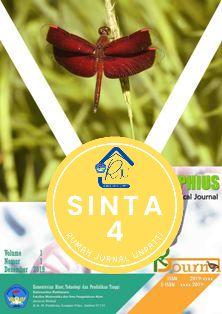Ethnopharmacy and Traditional Knowledge Study with a Family Use Value Approach in Sumberbrantas Village, Bumiaji District, Batu City, East Java
Abstract
Indonesia is recognized as one of the world’s most biodiverse countries, with an estimated 17% of global plant and animal species found within its borders. This biodiversity supports a wealth of medicinal plants that have been traditionally utilized by local communities. However, rapid modernization has led to a decline in the transmission of ethnobotanical knowledge. This study investigates the ethnopharmacological practices in Sumberbrantas Village, Bumiaji District, Batu City, East Java, with a focus on the Family Use Value (FUV) approach to identify the most utilized plant families in traditional medicine. Data were collected through structured interviews with 70 respondents selected using purposive and snowball sampling techniques. The study analyzed the FUV and Fidelity Level (FL) of various plant species to determine their significance in traditional healing practices. Results indicate that the Zingiberaceae and Euphorbiaceae families have the highest FUV (0.45), highlighting their widespread use in treating various ailments. Conversely, the Oxalidaceae family exhibits the lowest FUV (0.01). The FL analysis shows that Allium cepa (shallot) has the highest fidelity level (75%), demonstrating its prominence in treating multiple conditions. This research provides critical insights into the preservation of ethnomedicinal knowledge and the sustainable use of medicinal plant resources. The findings serve as a valuable reference for conservation efforts and the development of community-based herbal medicine initiatives.
Downloads
References
REFERENCES
Amrul, N., Rahman, A., & Setiawan, B. (2017). Ethnobotanical research methods: A practical approach. Yogyakarta.
Andesmora, R., Susanti, H., & Pratama, A. (2022). Ethnobotanical study of medicinal plants in the Zingiberaceae family in North Bengkulu Regency. Journal of Tropical Biology, 20(1), 45–58.
Apriliani, I. D., Suryati, E., & Hidayat, T. (2014). Utilization of shallot skins (Allium cepa L.) as a natural dye for salted eggs. Indonesian Journal of Fishery Product Processing, 17(3), 236–243.
Aseptianova, A., & Yuliany, S. (2020). Antibacterial activity of ethanol extract of Averrhoa bilimbi L. leaves against Staphylococcus aureus and Escherichia coli. Indonesian Journal of Pharmaceutical Sciences, 18(1), 1–8. http://eprints.ums.ac.id/id/eprint/20705
Auliani, N., & Sofiyanti, N. (2014). Diversity and utilization of medicinal plants in the Zingiberaceae family in Kampar Kiri Tengah District, Kampar Regency, Riau Province. Biodiversity Journal, 15(2), 123–129.
Batoro, J. (2013). Diversity of medicinal plants and their role in community life. Malang: Universitas Brawijaya Press.
Calzada, F., & Bautista, E. (2020). Family use value of medicinal plants used in the Huasteca Potosina, México. Journal of Ethnopharmacology, 259, 112999. https://doi.org/10.1016/j.jep.2020.112676
Fernandi, A., & Nursyahra, I. (2008). Kandungan senyawa metabolit sekunder dan aktivitas farmakologi dari tanaman famili Zingiberaceae. Jurnal Farmasi Indonesia, 5(3), 157-165.
Harborne, J. B. (1996). Phytochemical methods: A guide to modern techniques of plant analysis (2nd ed.). London: Chapman & Hall.
Hoffman, B., & Gallaher, T. (2007). Importance Indices in Ethnobotany. Ethnobotany Research and Applications, 5, 201–218. Retrieved from https://ethnobotanyjournal.org/index.php/era/article/view/130
Jadid, N., Arifin, Y. F., & Setiawan, A. (2020). Analysis of the use value of medicinal plant families in Sumberbrantas Village, Bumiaji District, Batu City, East Java. Wallacea Forestry Research Journal, 9(1), 1–10.
Katno, K. (2008). The role of medicinal plants in traditional medicine in Indonesia. Journal of Tropical Biology, 8(2), 45–58.
Khan, M. P. Z., Ahmad, M., Zafar, M., Sultana, S., Ali, M. I., Sun, H., & Xu, Y. (2014). Ethnomedicinal uses of edible wild fruits (EWFs) in Swat Valley, Northern Pakistan. Journal of Ethnopharmacology, 173, 191–203. https://doi.org/10.1016/j.jep.2015.07.029
Meidatuzzahra, R., & Swandayani, R. (2020). Utilization of Zingiberaceae plants as traditional medicine by the community of Sumberbrantas Village, Batu City. Journal of Community Service, 2(3), 150–158. https://doi.org/10.35580/bionature.v21i2.16494
Meliki, R., & Lovadi, A. (2013). Utilization of medicinal plants in traditional medicine in rural areas. Herbal Health Journal, 5(1), 10–18.
Muhlisah, S. (2007). Conservation of ethnobotanical knowledge in traditional medicine in Indonesia. Journal of Indonesian Ethnobotany, 4(2), 33–41.
Mukhsin, M. (2017). Purposive sampling technique in qualitative research. Journal of Social and Humanities Sciences, 6(1), 123–129.
Mutiah, R. (2015). Pharmacological activity of curcumin as an anticancer agent. Indonesian Journal of Pharmaceutical Sciences, 13(2), 136–143.
Muttaqin, A. (2016). Tourism potential in Sumberbrantas Village and its impact on community welfare. Nusantara Tourism Journal, 7(1), 89–105.
Nandika, D. (2005). Indonesia’s biodiversity and its utilization. Journal of Environmental Conservation, 10(1), 22–29.
Shanmugam, M. K., Rane, G., Kanchi, M. M., Arfuso, F., Chinnathambi, A., Zayed, M. E., ... & Sethi, G. (2015). The multifaceted role of curcumin in cancer prevention and treatment. Molecules, 20(2), 2728-2769. https://doi.org/10.3390/molecules20022728
Neksen, P., & Sumprojo, H. (2016). Community participation in village development: A case study of Sumberbrantas Village, Batu. Regional Development Journal, 12(3), 45–58. https://doi.org/10.3390/molecules26237109
Phillips, O., Gentry, A.H. The useful plants of Tambopata, Peru: II. Additional hypothesis testing in quantitative ethnobotany. Econ Bot 47, 33–43 (1993). https://doi.org/10.1007/BF02862204
Putri, D. P., Sari, R. M., & Yuliani, S. (2021). The potential of active compounds from spice plants for edible film packaging: A review. Journal of Food Technology, 12(1), 1–10. https://doi.org/10.36441/jtepakes.v5i1.1670
Lestari, A. M., Sari, F. H., Ifadha, F. I., & Amilia, F. N. Convergence and Utilization of Local Medicinal Plants for Elementary School Students to Improve Local Wisdom-Based Learning. In Social, Humanities, and Educational Studies (SHES): Conference Series (Vol. 7, No. 3). https://doi.org/10.20961/shes.v7i3.92642
Almomani, H., Patel, N., & Donyai, P. (2023). Reasons that lead people to end up buying fake medicines on the internet: qualitative interview study. JMIR Formative Research, 7(1), e42887. https://formative.jmir.org/2023/1/e42887/
Supeni, R. (1994). Biodiversity and its conservation efforts in Indonesia. Jakarta: LIPI Press.
Suryana, I. (2009). Biodiversity conservation strategies in Indonesia. Jakarta: Ministry of Environment.
Tambaru, R., Syamsuddin, R., & Amir, M. N. (2019). Antibacterial activity of ethanol extract of basil leaves (Ocimum basilicum L.) against Staphylococcus aureus and Escherichia coli. Pharmacy Journal of UIN Alauddin Makassar, 6(1), 1–8. https://doi.org/10.35451/jfm.v2i2.368
Waheed, M., Zafar, M., Khan, S., Ahmad, M., & Jan, G. (2020). Bioactivity evaluation and phytochemical screening of Euphorbia helioscopia and Rumex dentatus. Food Science and Technology, 42, e66721. https://doi.org/10.1590/fst.66721
Yassir, M., & Asnah, A. (2019). Antibacterial activity of green betel leaf extract (Piper betle L.) against Staphylococcus aureus and Escherichia coli. Manuntung Scientific Journal, 5(1), 1–7. https://doi.org/10.56314/inhealth.v1i1.23
Yeung, A. W. K., Heinrich, M., & Atanasov, A. G. (2020). Ethnopharmacology—a bibliometric analysis of a field of research meandering between medicine and food science? Frontiers in Pharmacology, 10, 1653. https://doi.org/10.3389/fphar.2018.00215
Hung, C. Y., & Yen, G. C. (2002). Antioxidant activity of phenolic compounds isolated from Mesona procumbens Hemsl. Journal of Agricultural and Food Chemistry, 50(10), 2993-2997. https://doi.org/10.1021/jf011454y
Copyright (c) 2025 Muhammad Ainur Rosyid Ridho, Indah Trisnawati, Tutik Nurhidayati, Kristanti Indah Purwani

This work is licensed under a Creative Commons Attribution-NonCommercial-ShareAlike 4.0 International License.
Authors who propose a manuscript and have it approved for publication know that the manuscript will be registered and become part of the RPBJ. Authors and readers understand that this journal is open and all its contents can be accessed freely, provided that RPBJ is still listed as the source of information. The hope is that this journal can become a vehicle for exchange and scientific knowledge for society and the scientific community, especially in the field of Biology and other branches of science.









